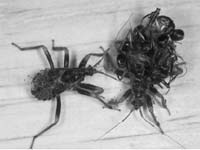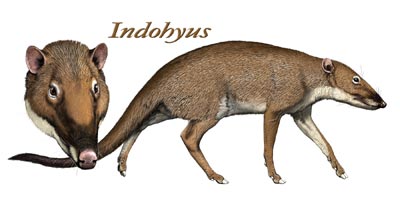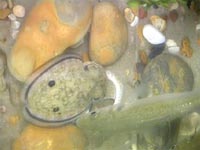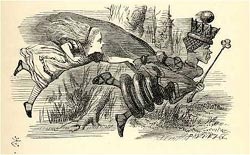As another year finishes and it’s been a good one for me. I won a writing award, got to talk to David Attenborough and started a freelancing career. Luckily, the Christmas break has provided some much-needed relaxation so before I launched renewed into 2008, I thought I’d take a look back and pick the favourite stories which I managed to write about over the last year.
This isn’t a list of the biggest or most important breakthroughs; they are simply the stories I enjoyed writing about the most. They represent a mix of quirky results, articles I was proud of, and sheer coolness – my top ten are in green. As always for this site, all stories were written from the actual papers, rather than press releases or other news coverage.
Once again, thanks to everyone who read, commented on, or linked to this site. Hope to see you all in the new year.
Evolution
 1) Living optic fibres bypass the retina’s back-to-front structure
1) Living optic fibres bypass the retina’s back-to-front structure
The human retina has an ‘incompetent design’ that forces light to cross a tangle of nerves and blood vessels before reaching the light sensors at the back. The mammalian eye has solved this problem by evolving living optic fibres – Muller cells – that funnel light through the messy retina.
2) Orang-utan study suggests that upright walking may have started in the trees
A study in orang-utans suggested that our ancestors may have evolved to walk on two legs while they were still in the trees, using a bipedal stance to traverse thin branches and canopy gaps.
3) Butterflies evolve resistance to male-killing bacteria in record time
It’s always a thrill to see examples of evolution in action. This year, the beautiful blue moon butterfly of Samoa provided just such an example by evolving resistance to a bacteria that was killing off its males within just 10 generations.
4) The evolution of the past tense – how verbs change over time
Evolution’s not just about genes. In a beautifully written paper, Harvard scientists mathematically modelled the evolution of English verbs, showing that irregular verbs become standardised according to an elegantly simple mathematical model.
Animal behaviour
 5) Moray eels attack ‘Alien-style’ with second pair of jaws
5) Moray eels attack ‘Alien-style’ with second pair of jaws
Even familiar animals can surprise us. Moray eels are common aquarium specimens but scientists only just discovered that they grab prey with a second set of scary Alien-style jaws that launch forwards from the back of the throat
6) Mobs of honeybees suffocate hornets to death
Cyprian honeybees are frequently attacked the formidable Oriental hornet. But the smaller, weaker bees defend themselves by working together. They mob the hornet, prevent it from expanding the breathing apparatus in its abdomen and suffocate it to death.
7) Fake cleaner fish dons multiple disguises
This year, the bluestriped fangblenny emerged as only the second animal that can change colour to mimic different species, depending on whether it wants a meal or protection. Other discoveries showed the strategic ways in which animals use defensive signals – ground squirrels heat up their tails to fool infrared-sensing rattlesnakes (but not other snakes) and cuttlefish flash up startling eye spots only in front of fish that hunt by sight.
Animal intelligence
 8] Chimps trump university students at memory task
8] Chimps trump university students at memory task
Chimps took plenty of opportunities to show how intelligent they are, not least by beating human university students at a memory test. Other studies found that chimps make their own spears to hunt bushbabies, pass on new traditions between groups, altruistically help each other out and even had their own equivalent of our Stone Age.
9) Elephants smell the difference between human ethnic groups
Elephants too have demonstrated that they are no slouches in the intelligence department. African elephants can tell the difference between human ethnic groups and react more fearfully to those that hunt elephants.
10) Clever New Caledonian crows use one tool to acquire another
Meanwhile, the astonishing New Caledonian crow showed that it can combine different tools to solve a problem, often on the first go. They are the only animals besides ourselves and the great apes that have shown this ability.
Palaeontology
 11) Microraptor – the dinosaur that flew like a biplane
11) Microraptor – the dinosaur that flew like a biplane
Flying birds evolved from land-bound dinosaurs, but like human aircraft, it seems that they may have gone through a two-wing design. A small feather dinosaur called Microraptor had wings on its legs too and used these to glide from tree to tree.
12) Evidence that Velociraptor had feathers
This year, scientists finally proved that Velociraptor had feathers on its arms, contrary to its makeover in Jurassic Park. Until now, that had always been an educated guess based on its evolutionary relatives, but small mounds of bone – quill knobs – provided conclusive proof.
13) Sabre-toothed cats had weak bites
The fearsome sabre-toothed cat, Smilodon, was found to have a surprisingly weak bite. It’s massive canines weren’t the brute blade of a swordsman, but the precise daggers of an assassin, used to deliver a quick killing blow to prey that was already wrestled to the ground.
Health and medicine
 14) Human skin cells reprogrammed into stem cells
14) Human skin cells reprogrammed into stem cells
In one of the most exciting breakthroughs of the year, two groups of scientists found a way of turning adult human cells back into the stem cells of embryos, bringing us closer towards treating a range of conditions with personalised stem cells. One such technique was used to cure mice of a genetic disease called sickle cell anaemia using stem cells reprogrammed from their own tails.
15) Brain parasite drives human culture
The thought of a microscopic creature controlling our actions isn’t a nice one, but it might be true. The brain parasite, Toxoplasma gondii, affects a huge proportion of the world’s population and could be a potent driving force of human culture.
16) Space flight turns Salmonella into super-bug
Some bad news for astronauts – a NASA study showed that bacteria react to the zero-gravity conditions of space by becoming extra-virulent super-bugs.
17) Human gut bacteria linked to obesity
Obesity may be down to food and exercise, but new research showed that the balance between two groups of bacteria in our digestive systems affects our risk of being fat.
18) Resistance to an extinct virus makes us more vulnerable to HIV
A fascinating study showed that modern infections of HIV may be the price we pay for immunity to an extinct virus. Millions of years ago, we evolved resistance to a virus called pTERV1 that plagued other primates but this adaptation makes us more vulnerable to HIV.
Environment and ecology
 19) How biofuels could cut carbon emissions, produce energy and restore dead land
19) How biofuels could cut carbon emissions, produce energy and restore dead land
It’s been a big year for biofuels – hailed as a solution to climate change, they have recently been accused to worsening the problem. But amidst the debate, a small paper went unnoticed, which found that cultivating a diverse mix of woody plants, legumes and grasses could produce biofuels in a way that would curb carbon emissions, produce renewable energy, restore unusable agricultural land and improve biodiversity.
20) Is a virus responsible for the disappearing bees?
Since 2006, a mysterious condition known as Colony Collapse Disorder has been causing entire hives of bees across the US and the UK to vanish. This year, a group of scientists finally found the cause – a virus called IAPV.
21) Restoring predator numbers by culling their prey
It’s been a fascinating year for ecology, with several papers showing that changes to food webs can have very unexpected results. A Norwegian case study epitomised this concept by showing that the best way to help out a threatened predator may be to counter-intuitively cull its prey. Along similar lines, other studies found that shark-hunting harms animals at bottom of the food chain.
Genetics and molecular biology
 22) An entire bacterial genome discovered inside that of a fruit fly
22) An entire bacterial genome discovered inside that of a fruit fly
In one of the most remarkable examples of gene transfer, scientists discovered that a bacteria called Wolbachia has transferred its entire genome into that of a fruit fly. These extreme gene transfers have important consequences for genome-sequencing projects.
23) Molecule’s constant efforts keep our memories intact
One study this year revealed our memories to be more fragile than we thought. Rather than being permanently writ in our minds, they only remain intact thanks to the constant action of a protein called PKMzeta. Block the protein and erase the memories.
24) Discovery of ‘fat gene’ highlights stigma against obese people
Earlier this year, a gene called FTO was identified as an obesity-related gene. More pertinently, it also highlighted the massive societal stigmas faced by obese people and the incredibly poor public understanding of the how genes affect behaviour.
Psychology
 25) Why music sounds right – the hidden tones in our own speech
25) Why music sounds right – the hidden tones in our own speech
All cultures around the world divide octaves into twelve semi-tones. Now, we know that this is because these musical intervals reflect the sounds of our own speech. They sound right because they match the frequency ratios hidden within the vowels of our languages.
26) Five-month-old babies prefer their own languages and shun foreign accents
It seems even five-month-old infants have strong prejudices – even though they can’t speak themselves, they prefer the sounds of their own languages and people who speak with native accents.
27) Subliminal flag shifts political views and voting choices
Subliminal messages can strongly affect behaviour, as a group of Israeli scientists found. They changed the attitudes of Israeli students to the Israeli-Palestine conflict, and their voting preferences, by showing them the national flag for just 16 milliseconds, not long enough to consciously register.
Neuroscience
 28) Simple sponges provide clues to origin of nervous systems
28) Simple sponges provide clues to origin of nervous systems
This year, the possible origins of the nervous system were found in the simple sponge, an animal with no nervous system of its own. Sponges carry the genetic components of synapses, which may have been co-opted by evolution as a starting point for proper nerve cells
29) Monkeys (and their neurons) are calculating statisticians
Using a simple psychological test, scientists showed that monkeys can use simple statistical calculations to make decisions and even managed to catch individual neurons in the act of computing.
30) ‘Brainbow’ paints individual neurons with different colours
Monkeys weren’t the only ones to have their neurons watched. One group of scientists developed a technique that paints the neurons of mice with over 90 colours using a palette of fluorescent proteins. This ‘Brainbow’ provides an unprecedented view of the connections in our brains.
Geology
 31) Megaflood in English Channel separated Britain from France
31) Megaflood in English Channel separated Britain from France
Just in time for the major summer floods in England, a group of scientists found that a megaflood broke through a land bridge that connected England to France, created the English Channel and separated Britain from the rest of Europe.
32) How India became the fastest continent
Continents may move slowly but among them, India is the champion sprinter. When it broke off from the supercontinent Gondwana, a plume of molten rock melted away India’s large rocky roots, turning it into a free-floating raft among strongly anchored peers.
Filed under: Personal stuff, Review, Uncategorized | Tagged: Animal behaviour, Animal intelligence, cience, Ecology, Environment, Evolution, Genetics, Geology, health, medicine, molecular biology, Neuroscience, Palaeontology, Psychology | 4 Comments »
![]() The animal world is full of charlatans. Some have bodies shaped by natural selection to fade into the background or resemble other harmful species. Yet others, like chameleons and octopuses, have the rare ability to actively change their colour or shape to actively hide themselves from view.
The animal world is full of charlatans. Some have bodies shaped by natural selection to fade into the background or resemble other harmful species. Yet others, like chameleons and octopuses, have the rare ability to actively change their colour or shape to actively hide themselves from view. Many species disguise themselves through their behaviour rather than their bodies; like human soldiers in camouflage gear, they don special suits to remain inconspicuous.
Many species disguise themselves through their behaviour rather than their bodies; like human soldiers in camouflage gear, they don special suits to remain inconspicuous. 






 1)
1)  5)
5)  8]
8]  11)
11)  14)
14)  19)
19)  22)
22)  25)
25)  28)
28)  31)
31) 
 Cuttlefish and their relatives, the octopuses and squid, are expert communicators whose incredible skins can produce a massive range of colours and patterns. Cuttlefish mostly use these abilities to blend into the background but they can also startle and intimidate predators by rapidly changing the display on their dynamic skins.
Cuttlefish and their relatives, the octopuses and squid, are expert communicators whose incredible skins can produce a massive range of colours and patterns. Cuttlefish mostly use these abilities to blend into the background but they can also startle and intimidate predators by rapidly changing the display on their dynamic skins. For decades, anthropologists have debated over why
For decades, anthropologists have debated over why 

 Now, a trio of scientists has shown that this effect is an illusion. When danger looms, we don’t actually experience events in slow motion. Instead, our brains just remember time moving more slowly after the event has passed.
Now, a trio of scientists has shown that this effect is an illusion. When danger looms, we don’t actually experience events in slow motion. Instead, our brains just remember time moving more slowly after the event has passed. These patterns of evolution are known as
These patterns of evolution are known as 
 For all the millions that are poured into electoral campaigns, a voter’s choice can be influenced by the subtlest of signals. Israeli scientists have found that even subliminal exposure to national flags can shift a person’s political views and even who they vote for. They managed to affect the attitudes of volunteers to the
For all the millions that are poured into electoral campaigns, a voter’s choice can be influenced by the subtlest of signals. Israeli scientists have found that even subliminal exposure to national flags can shift a person’s political views and even who they vote for. They managed to affect the attitudes of volunteers to the 


